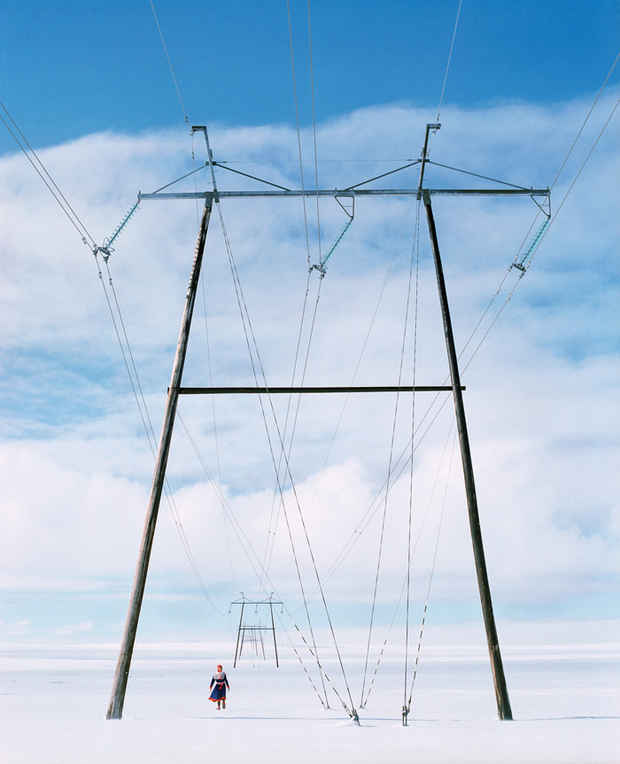“Sámi Stories: Art and Identity of an Arctic People” Exhibition
Scandinavia House

This event has ended.
“Sámi Stories” is a landmark exhibition examining the history, identity, and visual culture of the indigenous Sámi people. Featuring a selection of contemporary artworks and traditional duodji (handicraft)— including a reindeer milk scoop, shaman’s drum, cradle, and a selection of hats and dolls— the exhibition offers visitors an overview of Sámi history and visual culture from the 17th century to the present.
The exhibition is organized by Northern Norway Art Museum, Tromsø University Museum, and The American-Scandinavian Foundation (ASF) in commemoration of the 25th anniversary of the Norwegian Sámi Parliament and 200th anniversary of the Constitution of Norway, and draws from major Norwegian collections to highlight the historical and contemporary cultural vitality of the Sámi.
The Sámi are the indigenous people of Sápmi, a territory comprising Northern Finland, Norway, Sweden, and Russia’s Kola Peninsula. Since the establishment of national borders in Fenno-Scandinavia, the Sámi have struggled for formal, legal recognition of their status and rights as an indigenous people, but were largely ignored until the late 20th century. In 1998, the Norwegian government passed constitutional Article 110a, which, for the first time, formally recognized the Sámi as a separate people u nder Norwegian law, and established the Sámi Parliament of Norway, a representative body for people of Sámi heritage. Historically, Sámi art has been the most important means of expression for the Sámi— a way to communicate Sámi identity, ideas, and values to the world outside Sámi— and Sámi artists have been deeply involved in Sámi cultural and political movements.
The exhibition offers an overview of Sámi history, politics, religion, and identity through the pairing of historical, cultural objects and contemporary artworks. Together, the works on view highlight the issues, traditions, ideas, and narratives that have shaped, and continue to shape, the Sámi people and culture. Several objects, like a shaman’s drum and hammer from c. 1600–1700, address Sámi religious practice, an ancient form of shamanism centered on painted skin drums. Sámi shamanism was forced underground in the 17th and 18th centuries, but many people continued to make offerings at the same sacred places, a number of which have been captured by contemporary Norwegian photographer Arvid Sveen in works from his 2003 series “Mythical Landscape.” In her collage “Grandmother’s 448 Treasures” (Áhkku 448 vuorkkát), Swedish Sámi poet and artist Rose-Marie Huuva addresses her Sámi-Laestadian religious background.
Sámi identity has long been bound up with reindeer, historically a crucial resource of the Sámi, the foundation of their livelihood and cultural identity, and an icon of “Sáminess” outside of Sápmi. This fact is evident in many of the older objects on view— a 19th-century reindeer harness, a horn knife, a birch reindeer milk scoop— as well as in the contemporary: Textile artist Aslaug Juliussen has been actively involved with reindeer herding for the past 20 years and incorporates reindeer remains into her fiber and textile works. Printmaker John Savio’s works depict the prominence of reindeer in Sámi communities and activities. And Finnish Sámi photographer Marja Helander explores the contrasts characteristic of modern Sámi life in a playful series of photographs entitled “Modern Nomads.”
Sámi history and politics are addressed in the works of Swedish Sámi textile artist and painter Britta Marakatt-Labba, who illustrates major Sámi events, among them the 1852 Kautokeino Rebellion and 1970s Alta Case, in her extensive, scrolling embroideries. Similarly, Norwegian Sámi printmaker Arnold Johansen focuses on the history and landscape of the Sámi territory of Finnmark in large scale, abstract woodcuts on paper. The exhibition also includes a number of prime examples of Sámi duodji, or traditional handicraft and artwork, including dolls, caps, and cradles, as well as Iver Jåks’ contemporary sculptures, which reference traditional Sámi handicraft techniques.
[Image: Marja Helander “Ánnevárri (Mount Annivaara)” from the series, ‘Modern Nomads’ (2002) photograph on aluminum, 19 x 15 3/5 in. (48 x 39.5 cm).]
Media
Schedule
from May 10, 2014 to August 09, 2014
Opening Reception on 2014-05-10 from 18:00 to 20:00